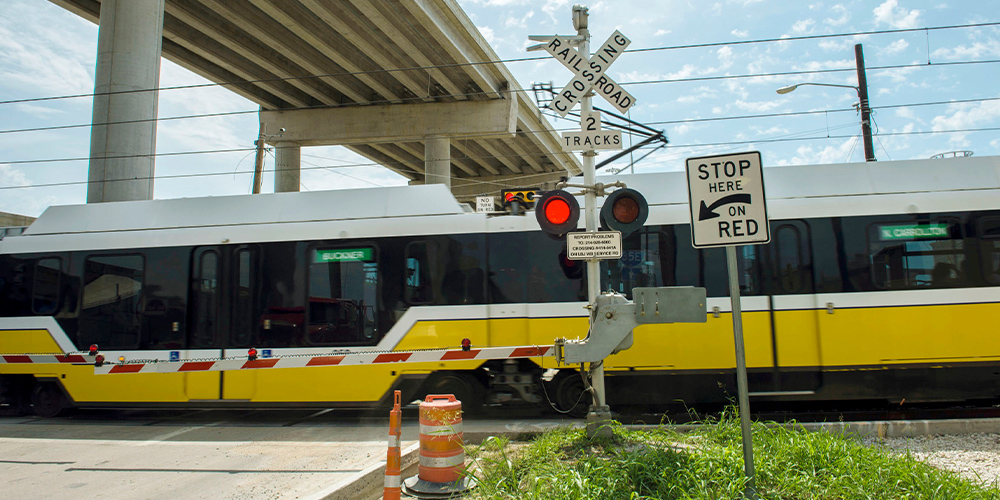Rail

States lack authority to enforce time limits on how long a railroad company can block a crossing. In 2001, the Fifth Circuit Court of Appeals ruled that federal laws preempt state anti-blocking statutes. Section 471.007 was removed from the Texas Transportation Code per the Texas attorney general's opinion in June 2005. You can read the opinion in full here.
If you are at a blocked crossing and you have an emergency, call 9-1-1.
States lack authority to enforce time limits on how long a railroad company can block a crossing, but you can report blocked crossings directly to the Federal Railroad Administration (FRA) by visiting their website.
You can also call the railroad directly by calling the number posted on the small, blue sign at the crossing.
- Locate the blue and white ENS sign at the nearest railroad crossing.
- Call the railroad's contact number listed on the blue sign posted at the crossing.
- Communicate your location by providing the identification number.
For more information on how to locate the ENS sign, watch this helpful video: Find the blue and white ENS sign PSA.
- Locate the blue and white ENS sign at the nearest railroad crossing.
- Call for help! Call the railroad's emergency contact number listed on the blue sign posted at the crossing or dial 9-1-1.
- Communicate your location by providing the identification number and state the nature of the emergency to the dispatcher.
For more information on how to locate the ENS sign, watch this helpful video: Find the blue and white ENS sign PSA.
The railroad is responsible for performing repairs on the road surface over the railroad crossties. The street or road entity for public crossings and the private owner for the private crossings are responsible for repairs to the roadway approaches up to the edge of the crossties.
Federal law requires the train horn to begin at least 15 seconds before the train approaches a rail/highway crossing of any public road. You might hear 2 long blasts, 1 short blast, and 1 long blast and that may vary if there are several crossings close together. Engineers may also use the train horn for other safety reasons such as trespassers, animals on track, obscured sight distance, etc.
Some cities have 'quiet zones' where train horns are not routinely used. The Federal Railroad Administration has a rule which allows certain communities to apply for quiet zones if the rule's requirements are met. You can read more about quiet zones on the FRA website.
The Federal Railroad Administration's Office of Safety maintains crossing accident and inventory information on the FRA website.
The FRA also maintains a mapping application with details of crossing and rail lines across the country.
All of the materials left by the railroad in their right of way is private property of the railroad. Though they may store materials for weeks or months, it is against the law to retrieve them.
Texas law forbids scrapping of railroad metal without permission from the railroad or state. This material is property of the railroad, and many scrap metal companies refuse to buy it without a letter from the railroad company. Only railroads issue salvage letters.
TxDOT recommends contacting your city or county maintenance department. You may also contact the operating railroad company with concerns directly along the track within the railroad right-of-way.
- Locate the blue and white ENS sign at the nearest railroad crossing.
- Call the railroad's contact number listed on the blue sign posted at the crossing.
- Communicate your location by providing the identification number.
Texas has a railroad clearance requirement in Chapter 191 of the Transportation Code. Vertical height above the top of the rail must be 22 feet and horizontal clearance must be 8.5 feet from the centerline of the track. If construction is within the clearance envelope, you must submit a clearance deviation application.
Freight railroads do not publish operational information due to security and other concerns. The times at which freight trains operate often vary. Passenger train schedules are available from the passenger service provider on their website.
Railroad construction, operation, and abandonments are regulated by the U.S Surface Transporation Board. Please visit their website for the latest project and contact information.
Tracks that appear to be unused or overgrown are not necessarily abandoned. Rail lines that have been dormant for many years are sometimes reactivated for train operations. TxDOT's Rail Division monitors STB abandonment proceedings to protect potential state interests. The STB process provides the most direct access to decision-making but TxDOT encourages public comments to be sent via email.
Contact our office at 512-416-2376 or email us.